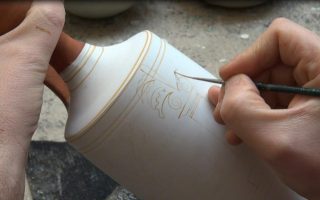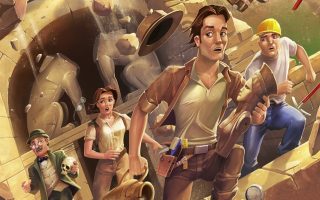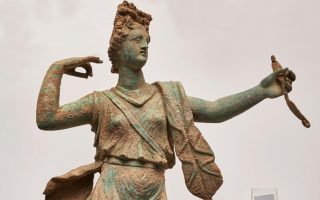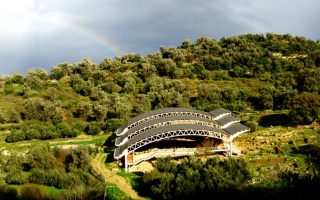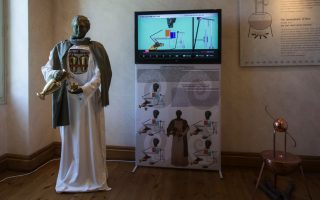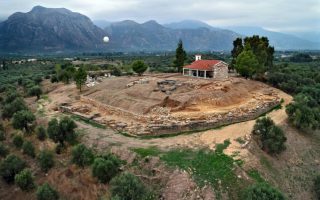Ephorate of Underwater Antiquities salvages lost chapters of history
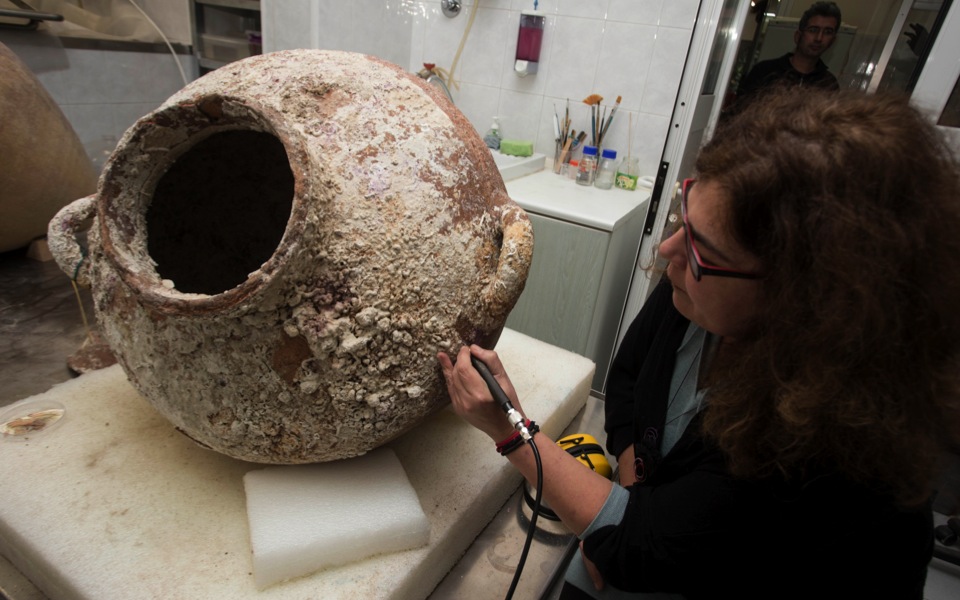
You want to hold your breath, as you do when you’re underwater, when gazing upon the splendid objects that archaeologists have dragged up from the deep. Ancient vases, Classical era jars, bronze figurines, Ottoman clay pipes from the 17th century, Byzantine coins and, most surprising of all, the contents of an amphora from Sinope in the Pontus region, found off the coast of the eastern Aegean island of Fournoi: 2,000-year-old shells of shrimps that were meant to feed a ship’s crew and which are now stored in a plastic food container.
Catching a glimpse of the valuable contents of the Ephorate of Underwater Antiquities (EEA) on Dionysiou Areopagitou Street in downtown Athens is a privilege reserved for just a few. You don’t know where to look first, while it’s hard not to touch the remains of a past that spent centuries hidden from human sight at the bottom of the sea before being brought to light.
I was greeted at the entrance by the head of the EEA, Angeliki Simosi, who took me on a tour of what she describes as “the country’s most special archaeological department, dedicated to the country’s biggest museum: the Greek seabed.” That is a “museum” that is not just huge in size (covering all of Greece’s territorial waters), but also in terms of time, as the findings to date range from the Stone Age all the way up to the 20th century.
“When a shipwreck is located, we bring up a sample of objects so that we can date them, roughly at first. Then we try to do a survey of the ship’s hull and, once its condition is ascertained, we can go ahead with the excavation if we feel that it is merited,” explained Simosi, who has served at the EEA since its founding in 1976.
There are hundreds of wrecks in the Greek seas, Simosi explained, but the service focuses its efforts on those that are considered most significant because of the cargo they were carrying when they went down.
“One of our duties is to scan the seabed to see whether there is more than one hull at the location,” Simosi said. “This year in Fournoi, our archaeologist Giorgos Koutsouflakis located 22 wrecks in a small area.”
When an object is first removed from the water, it is immediately placed in a container with seawater and once it arrives at the EEA it is transferred to a tank, where the desalination process, which can take anything from a few months to years, begins. This painstaking process is essential to protect the object, as any abrupt changes to the environment in which it has existed for perhaps hundreds of years can cause rapid deterioration.
“Every so often, we take the object out and slowly clean off the various layers that have built up on its surface,” said Simosi.
Once this process is complete, it is up to the conservation experts to reveal the wood, metal, clay or marble beneath. With patience and care, they spend hours returning every single object to its original form, put it back together and clean it.
Two of the conservationists who work at the EEA, Angelos Tsombanidis and Spyridoula Papanikou, feel privileged to be tasked with bringing such treasures back to life and they confess that it can be an emotional process at times. “One experience that we will always remember is when we had to restore a child’s skull, found in a sunken ancient settlement in Metochi in the Pagasetic Gulf. It is dated to the middle Bronze Age, around 1700 BC. A characteristic of the settlement is that they would bury their children inside the home.”
The most impressive find made so far is locked in a glass cabinet on the ground floor of the EEA. It is parts of a large statue from the late Hellenic period with a fascinating history.
In 2006, a fisherman brought up the leg of a bronze statue in his nets, in the area between the islands of Kalymnos and Kos. Shortly afterward, another fisherman, who happened to be related to the first one, found the other leg in the same area. He found part of the torso in 2009, while the head and other parts of what is believed to be a military leader on horseback turned up here and there later. What is odd about the story is that while the fishermen pointed out the spot to the EEA, archaeologists have been unable to find any other trace of the statue. Over the years, research has suggested the parts belong to a figure of an imposing man on horseback, holding the reins in one hand and saluting with the other. No trace of the horse has been found.
“The torso spent a long time in the desalination tank and is a perfect fit to the legs,” said Simosi. “We can’t be sure about the head because it’s not in Greece right now. It is on loan and being exhibited abroad. First it went to Florence, then to America and next it will be shown at a major exhibition of ancient Greek art in Japan. From our experience, though, we believe it to be a part of this very big and very beautiful statue.”
The conservationists gave me a special treat. They opened the cabinet and carefully removed the legs. Tsombanidis held them upright to give me an idea of what they would look like in their proper position.
“As you can see, every day is special for us, full of surprises,” the EEA staff said as they saw me out.
